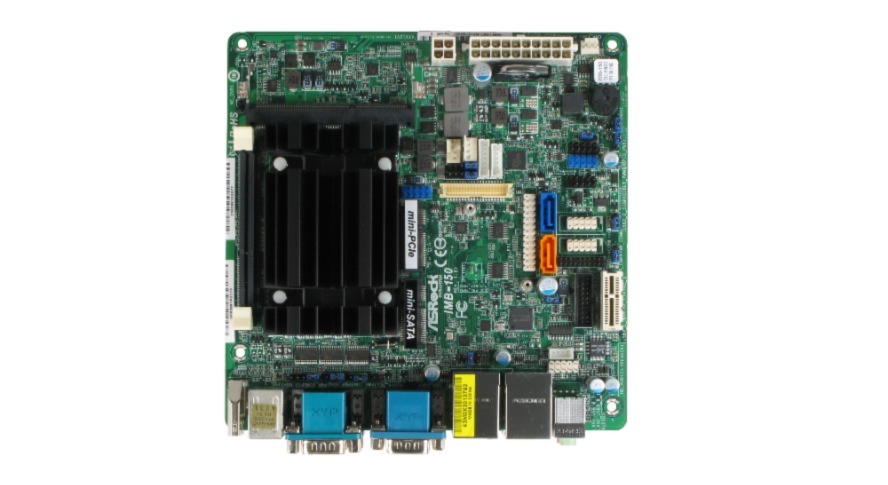What is a Mini-ITX motherboard? A Brief Breakdown of Motherboard Sizes
If you’re new to the world of industrial or small form factor (SFF) computing, you might be asking, “what is mini-ITX?” There are many motherboard sizes and in this blog, we’ll break them down and compare their sizes and use cases.
Mini-ITX is a compact motherboard form factor measuring 170 × 170 mm (6.7 × 6.7 in). Mini-ITX boards are specifically designed for computer builds that require full-featured capabilities in a compact footprint. They’re a popular choice for a wide range of consumer and industrial computing systems.
The Mini-ITX standard was originally developed by VIA Technologies in 2001 to showcase chipsets and processors. The form factor was of particular interest to industrial hardware builders because it maintained many of the capabilities and connectivity options of larger boards while saving space and drawing less power. Mini-ITX boards are well suited for fanless cooling, making them ideal for industrial and embedded systems that require high reliability in challenging environments. OnLogic was among the first companies to make Mini-ITX boards available to the US market in 2003.
Mini-ITX motherboard size comparison
Most modern consumer and enthusiast PCs are built around a standard-ATX motherboard, which measures 305 x 244 mm. (12 x 9.6 in). The size of this board allows users to maximize expansion and customization options.
However, because of its larger size, an ATX board can be difficult for industrial installations where space is a concern. The number of components on ATX boards also means they require more power and, as such, more cooling.
A fairly common alternative to ATX is the Micro-ATX motherboard, which reduces the size of the board to either 244 x 244 mm (9.6 x 9.6 in) or 244 x 205 (9.6 x 8.1 in). Of course, that reduction in size does also result in fewer expansion options. Check out the image below that shows the largest to smallest motherboard.
For many industrial system builders, Mini-ITX strikes an appealing balance of performance, size, cooling capabilities, and power draw. That said, there are a number of smaller motherboard options for users who put even more of a premium on space savings and low power draw:
- Nano-ITX motherboards were another form factor proposed by VIA Technologies in 2003, measuring 120 x 120 mm (4.72 x 4.72 in). They saw some early adoption, particularly in digital entertainment.
- Intel NUC motherboards were launched in 2013 and measure 101.16 x 101.16 mm (4 x 4 in). NUC computers and motherboards still remain a popular option for consumer and commercial applications.
- Pico-ITX motherboards were introduced by VIA Technologies in 2007. They measure just 100 x 72 mm (3.94 x 2.83 in). Pico-ITX boards are often deployed in embedded applications due to their extremely small footprint.
There are also a number of other motherboard sizes as well as single board computing (SBC) solutions, like the Raspberry Pi, that package a motherboard together with storage, memory, and onboard processing.
Advantages of Mini-ITX
Mini-ITX offers a number of advantages over its larger (and smaller) contemporaries. Of course, every application is unique, and your requirements will dictate which form factor has the right combination of features and performance for your project. That said, here’s a summary of what Mini-ITX motherboards have to offer.
- Small systems for space constrained applications: Compact Mini-ITX PCs fit where most tower PCs don’t.
- Power efficient, but highly capable: Low power processors generate less heat which promotes system longevity. But they still deliver highly-capable processing, particularly with the latest processor generations.
- Commercial off-the-shelf (COTS) boards lower cost, speeds time to market: Standard, off the shelf Mini-ITX boards reduce the need for custom development.
- A range of suppliers and an established ecosystem: Mini-ITX has been around for more than two decades and there are hundreds of board and enclosure options to choose from.
- Industrial solutions available: Thanks to their flexibility, industrial manufacturers offer wide-temp, rugged, fanless, and long lifecycle board versions.
- Modularity and selection yield highly configurable solutions: Mini-ITX enables customized configurations thanks to onboard pin headers and the capabilities of solution providers like OnLogic.
Mini-ITX PC options from OnLogic
Hopefully that helps answer your questions about Mini-ITX. If you’re looking for an industrial system that utilizes one of these small form factor boards, you can browse our full line of Mini-ITX computer systems. If you have questions about which motherboard or system is right for you, reach out to our team.
Note: This post was originally posted on August 10th, 2022. It was updated on April 3rd, 2023.
Get the Latest Tech Updates
Subscribe to our newsletters to get updates from OnLogic delivered straight to your inbox. News and insights from our team of experts are just a click away. Hit the button to head to our subscription page.
Share
More Articles
OnLogic Industrial Computers
Discover OnLogic's multitude of industrial computers that will help you to advance your IoT project
Learn more at OnLogic.com
OnLogic Industrial PCs: Designed to last. Built to order. Delivered in days. Visit our online store at OnLogic.com






